The product recommendations in this post are recommendations by the writer and/or expert(s)
interviewed and do not contain affiliate links. Meaning: If you use these links to buy
something, we will not earn a commission.
When it comes to comfort foods, chicken tenders are high up on the favorites list. They’ve got the crunch and juiciness, and they’re just as delicious in a sandwich stacked with pickles as they are on their own, dipped into honey mustard. Plus, they’re convenient and can make for a quick, easy—and even healthy—meal when you’re short on time.
“Where chicken tenders land on the scale of ‘healthy’ to ‘unhealthy’ can be dependent on several different factors, including the type of ingredients and parts of the chicken used and the preparation and cooking methods used,” says Andrea Jordan, RDN, a dietitian with Top Nutrition Coaching. Many packaged chicken tenders in the freezer aisle are heavily breaded and high in sodium and saturated fat. Too many calories and unhealthy fats can contribute to heart disease, obesity, and other health problems, while a diet high in sodium can increase your risk for heart issues, Jordan says.
But, nowadays, there are a bunch of better-for-you chicken tenders that are breaded with healthier ingredients and are lower in sodium. Many of these products can be flash-fried or baked to decrease the amount of added fat, making these chicken tenders a tasty and healthy option, Jordan says.
Here, Jordan and Destini Moody, RDN, another dietitian with Top Nutrition Coaching, explain how to shop for healthy frozen chicken tenders.
How to choose healthy frozen chicken tenders
- Watch the sodium: Frozen foods, like chicken tenders, are often high in sodium because salt acts as a preservative. What’s more, many brands may prepare their chicken in a salt brine, which increases the sodium content even more. Because a high-sodium diet can contribute to heart issues, Moody recommends choosing chicken tenders with a sodium daily value of 20% or less per serving — that comes out to 460 milligrams.
- Look for more protein than carbs: Chicken tenders often act as the protein source in your meal, so they should contain a significant amount of protein. “Ideally, your brand should have 15 grams of protein or more per serving, and there should be more protein than grams of carbs as these carbs likely come from the breading and have little nutritional value,” Moody says.
- Avoid hydrogenated oils: Always check the nutrition facts label for trans fats and the ingredient list for hydrogenated oils. Both of these are “known for causing harmful inflammation in the body,” Moody says.
Now that you know what to look for in a nutritious chicken tender, here are the best and worst brands at the grocery store. And for the next time you’re dining out, don’t miss these 8 Best & Worst Fast-Food Chicken Tenders.
The 5 Healthiest Chicken Tenders
Best: Caulipower Chicken Tenders
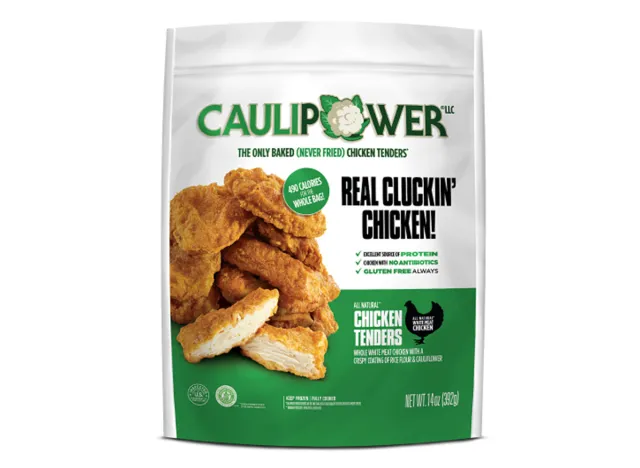

Per 2-pc serving: 110 calories, 1.5 g fat (0 g saturated fat), 370 mg sodium, 11 g carbs (1 g fiber, 0 g sugar), 14 g protein
Caulipower is known for its lower-carb creations that take comfort food to new levels. And these chicken tenders stand out because they’re breaded with rice flour and cauliflower, which adds some fiber and micronutrients. Jones loves that the brand doesn’t use oil to flash-fry the breading onto the chicken tender, which makes these tenders much lower in fat than most competitors. “Paired with the lower sodium content, this one’s a heart-healthy winner,” she says. Plus, they’re ready in a jiffy—all you have to do is pop them into an oven set to 425 degrees Fahrenheit and cook them for about 20 minutes.
Best: Realgood Foods Lightly Breaded Chicken Breast Strips
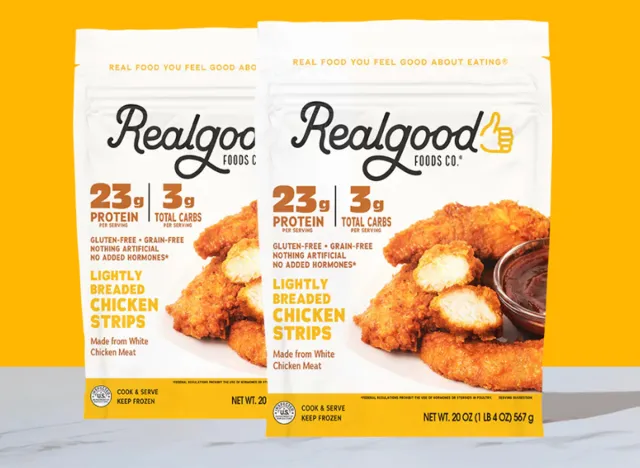

Per 4-oz serving: 160 calories, 6 g fat (0.5 g saturated fat), 370 mg sodium, 3 g carbs (0 g fiber, 1 g sugar), 23 g protein
These tenders are very lightly breaded with chickpea flour, so you’ll get more protein than carbs in each bite. “More breast meat and less breading allow this product to have more protein per ounce than most chicken tenders,” Jordan says. A 4-ounce serving of these tenders packs 23 grams of protein, which means you’ll stay fuller for longer after snacking on these. Aside from keeping you satiated, protein is an essential nutrient needed to build and maintain muscle mass, Jordan says. Try pairing a couple of chicken tenders with a fresh green salad topped with cooked quinoa or sweet potato for a balanced post-workout meal.
Best: Tyson Natural Gluten-Free Breaded Chicken Breast Strips
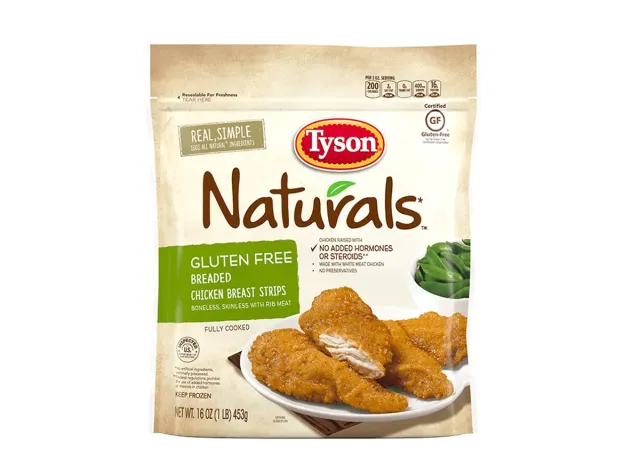

Per 3-oz serving: 200 calories, 10 g fat (2 g saturated fat), 400 mg sodium, 12 g carbs (0 g fiber, 0 g sugar), 16 g protein
Tyson is a popular brand, so you’re likely to find these chicken tenders in many grocery stores around you. Jordan loves that these tenders don’t contain any preservatives and are breaded with gluten-free ingredients, so they’re A-OK for people with celiac disease or those with a gluten intolerance. The breading is made up of yellow corn flour and brown rice flour, which provide both the taste and crunch that you’d expect from a chicken tender but without the high sodium content usually found in breaded products. And we love a lower-sodium frozen food product. “Reduced sodium diets can lower your risk of arterial disease and other health problems,” Jordan says.
Best: Applegate Naturals Homestyle Chicken Breast Tenders
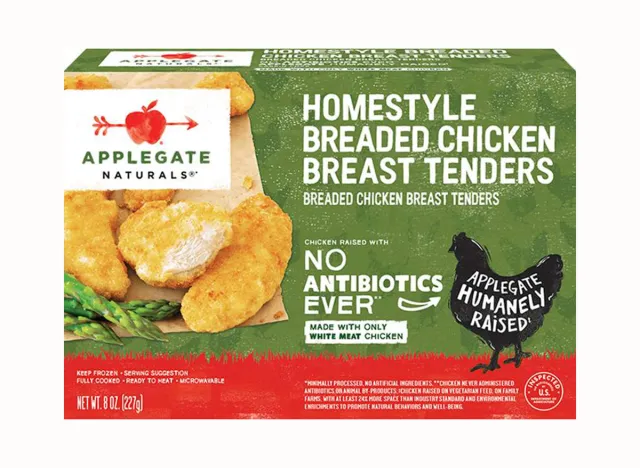

Per 3-oz serving: 160 calories, 6 g fat (1 g saturated fat), 320 mg sodium, 13 g carbs (0 g fiber, 1 g sugar), 13 g protein
These Applegate chicken tenders are made with simple ingredients, including organic and humanely raised chicken. “A plus for this natural product is the low amounts of sodium and cholesterol, as high intakes of either sodium or cholesterol can increase your risk of heart disease,” Jordan says. You can cook these in the oven, microwave, or air fryer for a quick and easy meal. Pair these tenders with a side of fiber-rich roasted veggies and cooked quinoa, which will provide some extra plant protein.
Best: Bell & Evan’s Breaded Chicken Tenders
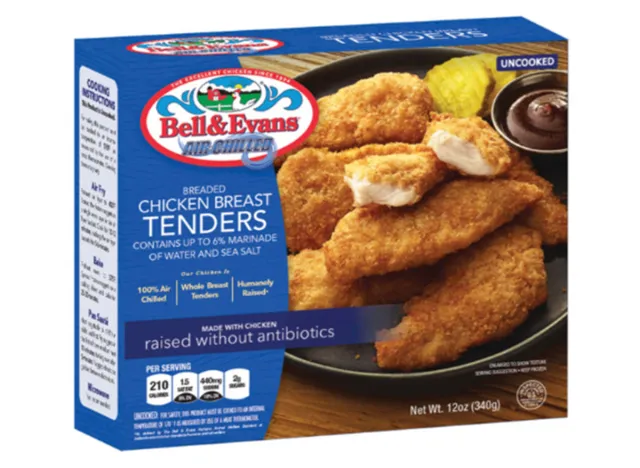

Per 4-oz serving: 210 calories, 9 g fat (1.5 g saturated fat), 440 mg sodium, 12 g carbs (1 g fiber, 2 g sugar), 20 g protein
Busy weeknights call for Bell & Evan’s top-rated tenders. While most chicken tenders are made using small cuts of chicken that are combined to form the tenders, these are unique because each tender contains a solid cut of chicken breast — this reduces the number of ingredients required and increases the amount of protein in each tender, Jordan tells us. Each serving packs 20 grams of satiating protein for just 210 calories. And “adequate protein intake can help keep our immune system strong,” Jordan says.
The 5 Unhealthiest Chicken Tenders
Worst: Good & Gather Crispy Chicken Breast Strips
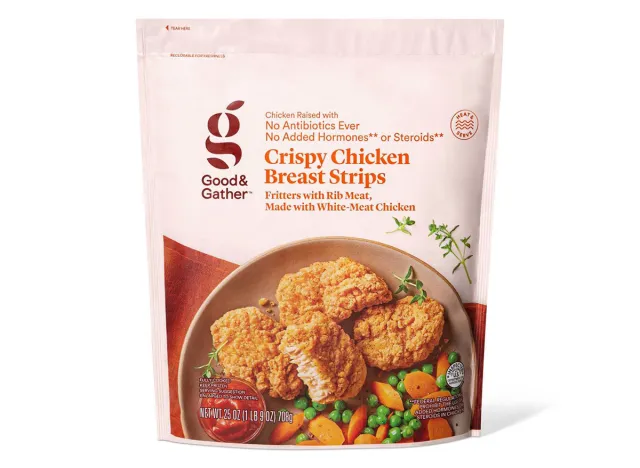

Per 3-oz serving: 190 calories, 8 g fat (1.5 g saturated fat), 600 mg sodium, 17 g carbs (0 g fiber, 1 g sugar), 13 g protein
These crispy tenders from Good & Gather, Target’s store brand, are riddled with 600 milligrams of sodium per serving — that’s 26 percent of your daily value. “Eating high-sodium foods too often can increase blood pressure, which can cause certain cardiovascular conditions like heart attack or stroke,” Moody says. If you do choose to sit down to these crispy battered tenders, make sure to watch your sodium intake for the rest of the day. The American Heart Association recommends no more than 2,300 milligrams of sodium per day for most people.
Worst: Country Pride Chicken Breast Tenders
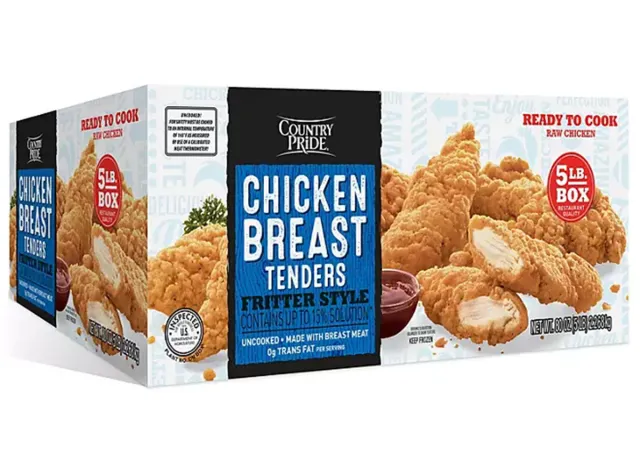

Per 4-oz serving: 270 calories, 11 g fat (2 g saturated fat), 890 mg sodium, 27 g carbs (1 g fiber, 0 g sugar), 17 g protein
Packing the most sodium and saturated fat of all the chicken tenders on our list, this pick from Country Pride is better left on your grocery store’s freezer shelves. These tenders are made with a salt brine, which significantly boosts the sodium content. “With just one serving, these tenders supply almost half your daily sodium allowance, which is a lot considering you can still dip them in salty sauces or serve them with salty sides,” Moody points out. Not only does one serving of these fritter-style tenders contain 39 percent of your daily value for sodium, but it’s also relatively high in empty carbs coming from the starchy breading.
Worst: Tyson Air Fried Chicken Breast Strips
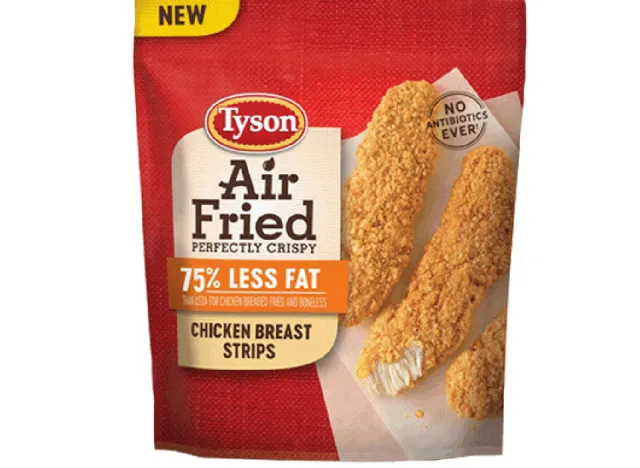

Per 3-oz serving: 150 calories, 4 g fat (1 g saturated fat), 570 mg sodium, 13 g carbs (1 g fiber, 3 g sugar), 16 g protein
Just because “air-fried” is plastered on the label, doesn’t mean these tenders are good for you. These might be lower in fat than your average fast-food chicken strips, but they still don’t get our dietitians’ stamp of approval. “As is often the case with reduced-fat food, other ingredients are often added to make it taste better. In this case, these chicken strips contain added sugar, which is known to cause inflammation in the body,” Moody says. Dip these tenders into just 3 tablespoons of ketchup, and your meal will amount to about 14 grams of sugar—that’s 3.5 teaspoons’ worth of sugar!
Worst: John Soules Food Buffalo Style Tenders
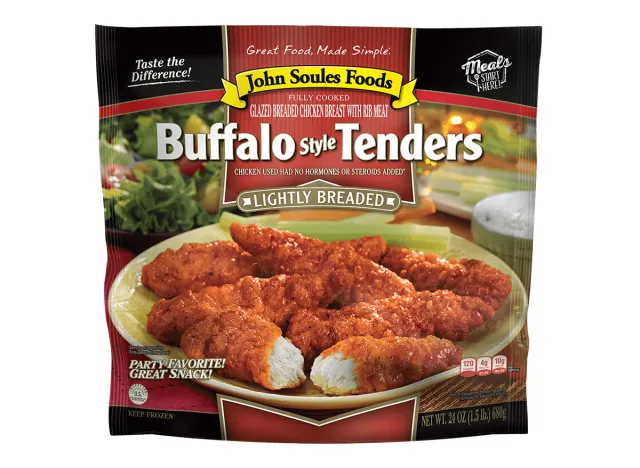

Per 1 piece: 120 calories, 4 g fat (0.5 g saturated fat), 650 mg sodium, 9 g carbs (0 g fiber, 0 g sugar), 10 g protein
These tenders are slathered in a spicy buffalo sauce that majorly cranks up the sodium content. What’s more, a serving size is only one tender, which has a measly 10 grams of protein — that likely isn’t enough to keep you full, and might lead you to overeat later on in the day, Moody says. But if you sit down to two tenders, you’ll double the nutrient numbers and end up taking in a staggering 1,300 milligrams of sodium, which is about 60% of your total daily sodium value.
Worst: Foster Farms Tangy Buttermilk Ranch Take Out Crispy Tenders
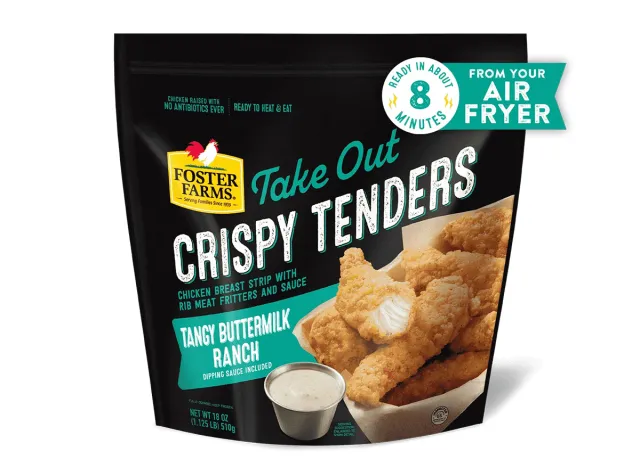

Per 3-oz serving: 190 calories, 8 g fat (1.5 g saturated fat), 600 mg sodium, 17 g carbs (0 g fiber, 1 g sugar), 13 g protein
These takeout-style tenders might rival those at your go-to fast-food chain, but that doesn’t mean they deserve to take up your freezer space. They’re actually advertised as a snack, likely because there are more carbs than protein in one serving, Moody says. “You may end up eating more than one portion, which, considering the sodium levels in these tenders are also quite high, could result in you consuming a lot more sodium than you should,” she says.

